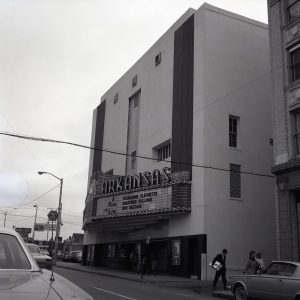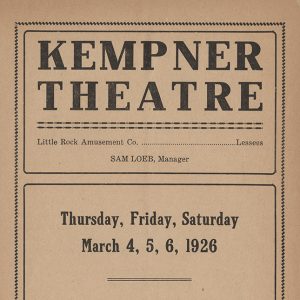calsfoundation@cals.org
Kempner Theater
Located in downtown Little Rock (Pulaski County), the Kempner Theater (sometimes spelled “Theatre”) was opened in 1910 as an “opera house” to distinguish such venues in small-town America from burlesque, which was considered a lower form of entertainment. The theater building, at 516 South Louisiana, was constructed in 1910 by brothers Dave and Ike Kempner, who were the owners of shoe and department stores in downtown Little Rock. With the coming of movies, the theater was remodeled in 1921 and again in 1929, when the name was changed to the Arkansas Theater. At the time of its closure in 1977, the former Kempner Opera House was the last movie theater remaining in downtown Little Rock.
Isaac “Ike” Kempner (1871–1931) was born in North Little Rock (Pulaski County). His younger brother, David Warren Kempner (1877–1962) was born in Little Rock. Their parents were merchant Jacob Kempner (1845–1896) and homemaker Sophia Blass Kempner (1848–1935). In the early twentieth century, the Kempner family was active in business, owning and managing such Little Rock landmarks as Kempner Brothers Shoe Store, Ike Kempner and Brothers Women’s Clothing, and Gus Blass Dry Goods Company.
In its original incarnation as the Kempner Opera House, the Kempner Theater was designed by New York architect Henry Beaumont Herts of the architectural firm Herts & Tallant. The façade of the building was said to be “Sullivanesque,” an architectural style for commercial buildings that was developed by famed Chicago architect Louis Sullivan. It was a popular style in the early twentieth century for local opera houses, characterized by designs such as leaves and vines. The exterior of the Kempner Theater was later altered into more of an Art Deco style that was highlighted by ceramic tile.
The Kempner Theater opened on September 20, 1910, with a comedy play called Billy, about which little is known. The Kempner had competition from about a dozen other downtown Little Rock theaters, although most closed in the early twentieth century. These included the Best Theater, the Crystal Theater (later called the Rialto), the Majestic, the New Theater, the Palace (renamed the Pulaski Theater and later called the Capitol), and the Royal Theater (later called the Center Theater). The Gem at 712 West Ninth Street catered to the city’s African American population, as the downtown theaters were segregated. If Black patrons were allowed inside downtown theaters at all, often via separate entrances, they were restricted to the balconies.
The interior of the Kempner Theater was remodeled in 1921 by Theo Sanders of the Little Rock architectural firm Sanders & Ginocchio. Sanders’s work was also seen around Little Rock at the Woman’s City Club building, Second Presbyterian Church, the M. M. Cohn Company, and Philander Smith University. The Art Deco style was extremely fashionable at this time, coinciding with the rise of movies as popular entertainment. Seating around 1,300 people, the Kempner Theater combined films with live shows in the 1920s. Like many such venues across America, the Kempner also hosted lectures, minstrel shows, musicals, operas, plays, and vaudeville acts, along with community events such as school graduations. When it began showing only movies, the name changed to the Arkansas Theater on September 27, 1929, one month before the stock market crash that signaled the onset of the Great Depression.
Through the following decades, the Arkansas Theater attracted varying numbers of moviegoers until the postwar era of the 1950s when Little Rock, like other American cities, began expanding to the suburbs. People no longer wanted to go downtown for their shopping and entertainment. In addition, with the advent of Cinemascope and other large-screen formats, the theater was not able to be widened to accommodate the wide-screen arrangement. Beginning in 1950, the United Artists Theater Circuit held a lease on the building. In the 1970s, the Arkansas Theater featured mainly “Blaxploitation” films that featured Black actors and were aimed at Black audiences. (By the late 1970s, Hollywood was moving away from that genre.) The Arkansas Theater closed permanently on October 4, 1977. The last offering at the former Kempner Theater was a double feature of its final two movies: J. D.’s Revenge, which starred Louis Gossett Jr., and Coffy, starring Pam Grier.
A few groups, including the Arkansas Opera Theatre, were approached to take over the building before it was deeded to the University of Arkansas Foundation in 1987. The theater sat vacant for almost twenty years, deteriorating beyond repair. It was not eligible for funding through a historic preservation designation because of the alterations to the interior and exterior over the decades. In 1995, the old Kempner Theater was demolished. The site became a parking lot across the street from the Lafayette Building (523 South Louisiana).
For additional information:
“Arkansas Amusement Corporation v. Kempner et al.” Justia. https://law.justia.com/cases/federal/appellate-courts/F2/57/466/1569663/ (accessed June 18, 2025).
“Arkansas Theatre.” Cinema Treasures. https://cinematreasures.org/theaters/27200 (accessed June 18, 2025).
“Final Movie Theatre in Downtown Little Rock.” Little Rock Culture Vulture. https://lrculturevulture.com/tag/kempner-theatre/ (accessed June 18, 2025).
LeMaster, Carolyn Gray. A Corner of the Tapestry: A History of the Jewish Experience in Arkansas, 1820s–1990s. Fayetteville: University of Arkansas Press, 1994.
“Little Rock’s Historical Downtown Movie Theaters” Mapping Project. Roberts Library, Central Arkansas Library System. https://robertslibrary.org/little-rocks-historical-downtown-movie-theaters/ (accessed June 18, 2025).
Menefee, Larry T. “A New Hypothesis for Dating the Decline of the ‘Road.’” Educational Theatre Journal 30 (October 1978): 343–356.
———. “The Syndicate War in Little Rock.” Arkansas Historical Quarterly 46 (Spring 1987): 27–45.
“Program, Kempner Theater.” Old Statehouse Museum. https://collections.oldstatehouse.com/objects/7502/program-kempner-theater (accessed June 18, 2025).
Waldrum, Benjamin. “Melvin John Kempner Jr.: Kempner’s Owner Cherished Family,” Arkansas Democrat-Gazette, June 19, 2007. https://www.arkansasonline.com/news/2007/jun/19/melvin-john-kempner-jr-kempners-owner-che-20070619/ (accessed June 18, 2025).
Nancy Hendricks
Garland County Historical Society
 Arkansas Theater
Arkansas Theater  Kempner Theater Program
Kempner Theater Program 



Comments
No comments on this entry yet.